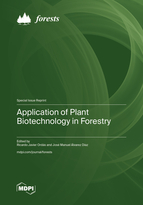Application of Plant Biotechnology in Forestry
A special issue of Forests (ISSN 1999-4907). This special issue belongs to the section "Genetics and Molecular Biology".
Deadline for manuscript submissions: closed (1 March 2023) | Viewed by 20497
Special Issue Editors
Interests: plant development; plant biotechnology
Special Issue Information
Dear Colleagues,
Forest trees constitute the majority of continental biomass and terrestrial biodiversity. They provide various ecological services and are a source of raw material for many essential purposes. In recent years, the need for wood and its derivatives has increased, and will continue to do so. Biotechnological tools such as genomic selection, micropropagation and genetic engineering will play an essential role in meeting this demand with the smallest possible environmental impact.
Forest regeneration after harvest is often left to natural processes, although prompt artificial regeneration with selected genotypes provides the most effective means to increase forest yield. Domestication of forest species through traditional plant breeding is technically more difficult and time-consuming than other crops due to their large size, long generation times, and prolonged juvenile stage. Genomic selection has the potential to accelerate breeding cycles, increase selection intensity, and improve the accuracy of breeding values. Currently, micropropagation techniques, together with the rooting of cuttings, are considered the most effective tools for the propagation of elite forest varieties at a large scale. Micropropagation exploits the characteristic developmental plasticity of plants to adapt to variable environmental conditions; in particular, their high regeneration capacity. Genetic engineering provides the potential to allow gene function analysis or to transfer specific traits into selected genotypes without affecting their desirable genetic background. Thus, genetic engineering provides a powerful tool to rapidly increase yield and wood quality in forest species, and allows the breeding process to be shortened substantially.
The objective of this Special Issue is to deepen our knowledge of the latest biotechnological approaches to forestry, such as rejuvenation through clonal propagation, including cuttings, micrografting and tissue culture; haploid generation; somatic embryogenesis; protoplast fusion; cryopreservation of germplasm; genetic engineering; and functional mapping of quantitative trait loci.
Dr. Ricardo Javier Ordás
Dr. José Manuel Álvarez Díaz
Guest Editors
Manuscript Submission Information
Manuscripts should be submitted online at www.mdpi.com by registering and logging in to this website. Once you are registered, click here to go to the submission form. Manuscripts can be submitted until the deadline. All submissions that pass pre-check are peer-reviewed. Accepted papers will be published continuously in the journal (as soon as accepted) and will be listed together on the special issue website. Research articles, review articles as well as short communications are invited. For planned papers, a title and short abstract (about 100 words) can be sent to the Editorial Office for announcement on this website.
Submitted manuscripts should not have been published previously, nor be under consideration for publication elsewhere (except conference proceedings papers). All manuscripts are thoroughly refereed through a single-blind peer-review process. A guide for authors and other relevant information for submission of manuscripts is available on the Instructions for Authors page. Forests is an international peer-reviewed open access monthly journal published by MDPI.
Please visit the Instructions for Authors page before submitting a manuscript. The Article Processing Charge (APC) for publication in this open access journal is 2600 CHF (Swiss Francs). Submitted papers should be well formatted and use good English. Authors may use MDPI's English editing service prior to publication or during author revisions.
Keywords
- micropropagation
- genetic engineering
- genomic selection
- somatic embryogenesis
- protoplasts
- cryopreservation






